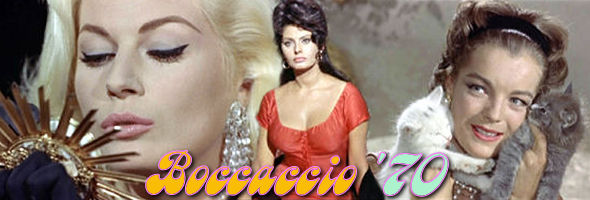
Color, 1962, 204m. / Directed by Mario Monicelli, Federico Fellini, Luchino Visctoni & Vittorio De Sica / Starring Marisa Solinas, Germano Giloli, Anita Ekberg, Peppino De Filippo, Romy Schneider, Tomas Milian, Sophia Loren / NoShame (US R1 NTSC) / WS (1.78:1) (16:9)
In the first story, struggling newlyweds Luciana (The Grim Reaper's Solinas) and Renzo (Giloli) try to meet the demands of modern life while stealing in quiet moments of romance, whether it's covert kisses in the office or a stealthy rendezvous beneath a public swimming pool (the segment's best scene). Short and sweet, this installment is an odd choice to open the film due to its unknown actors and comparatively mild tone (no wonder Ponti excised it); however, on its own terms there's plenty of charm to be found as the performers exude a natural, lively chemistry. While Solinas went on to enjoy a long and healthy career, the equally charismatic Giloli strangely vanished after making one more feature. Film score fans will also be happy to finally
Next up is the film's most famous sequence, "The Temptation of Dr. Antonio," in which a small town's bespectacled moral guardian is tormented by a huge billboard featuring the curvaceous form of Anita Ekberg. While bands of eccentric denizens cavort nearby, he experiences a paralyzing vision of an enormous Ekberg coming to life and tormenting him with the promises of giant-sized sexual indulgences. Packed with deliberately excessive double entendres (Nino Rota's score relies upon the repeated chant of "Milk! Milk!" while dairy bottles are held in front of Ekberg's breasts), this is pure Fellini from start to finish and offers the anthology's one foray into fantastic cinema. (It was also Fellini's first effort in color, believe it or not.) Though this particular bit comes close to wearing out its welcome, Fellini's original cut ran an astonshing 80 minutes; the mind boggles. Apparently the image of a gargantuan Ekberg was impressive to producers Harry Salztman and Albert R. Broccoli, who reused Ekberg's billboard likeness for an amusingly sinister sequence in From Russia with Love. Incidentally, this is the "half" referred to in the title of Fellini's later masterpiece, 8 1/2.
The third installment offers a far more subdued contribution from Luchino Visconti, who seems to be trying a dry run for the next year's The Leopard with "Il lavoro" ("The Key"). Spending most of her time lounging around at home, Pupe (a ravishing Schneider) is
Finally we reach Vittorio De Sica's "La riffa" ("The Raffle"), which was obviously intended to be the big crowd-pleaser of the bunch thanks to an emphasis on Sophia Loren's earthy sexuality and a naughty-but-moral story designed to tease guilty Cathoics in the audience. Here the famous bombshell portrays Zoe, a carnival employee who winds up as the prize for a Saturday night raffle. Learning her "company" is being offered for the evening, one poor customer pleads with her to let him win... so she decides to tamper with the raffle results, leading to comic consequences. A pleasant but innocuous diversion, this segment seems designed to show off Southern Italy's local color and benefits from the always enjoyable Loren; however, for some reason it doesn't have the staying power of its predecessors and polishes off the quartet of stories on a strangely bland note.
Released by Joseph E. Levine in most English territories through Embassy Pictures, Boccaccio '70 proved to be another Italian hit that boosted the already ascending reputations of its directors, all of whom turned to far more challenging and difficult material in the following years (while offering further anthology contributions in far more eccentric outings like Spirits of the Dead and The Witches). The kind of experiment that would never get off the ground today, it's a fascinating primer on '60s Italian art house cinema and still offers plenty of good-natured pleasure.
Strangely withheld in many countries for years on home video, Boccaccio '70 looks fantastic on DVD with a transfer from the original, full-length negative. Interestingly, the color schemes (particularly the first segment) are more restrained than one might expect as flesh tones have a soft, powdery texture, similar to the look of Visconti's Senso. The packaging indicates an anamorphic presentation framed at 1.66:1, though it's actually closer to about 1.73:1 and will be framed off at 1.78:1 on an anamorphic television. The framing might be a hair too tight in a couple of shots, but it's not tremendously distracting. The first segment can only be played in Italian, but the rest of the film can be watched either in Italian with optional English subtitles or English-dubbed. Surprisingly, unlike most big Italian productions this wasn't shot with the actors mouthing English dialogue to be looped later; the Italian track is by far the preferable option as the English track is obnoxious and clumsy throughout.
Fortunately the rest of the package lives up to the satisfying technical presentation. Spread out over two discs (with a pair of stories for each), the DVD also delivers a reel of raw behind the scenes footage, the general release credits and story interstitials (from a dupey source), the theatrical trailer, and thick, fold-out booklet containing a reproduction of the theatrical poster on one side and extensive, illustrated liner notes (well worth a read) on the other.
Financed by legendary producer Carlo Ponti, this anthology film geared towards showcasing its all-star roster of directors kicked off a craze for omnibus stories (usually comedic, erotic, or horrific) which poured out of Europe for the next two decades. As the title implies, the central
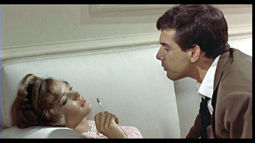 gimmick involves bringing the bawdy, good-natured tone of Giovanni Boccaccio's stories to the screen with a modern twist, though the writer's influence would be difficult to detect without the title. (It wasn't until Pasolini's The Decameron eight years later that the scribe really got his due.) Of course, a sprawling sex comedy wouldn't work at the time unless it was peppered with gorgeous international starlets, so Anita Ekberg (reuniting with Fellini fresh from La Dolce Vita), Romy Schneider, and Sophia Loren were recruited to provide eye candy. The film originally unspooled at its Italian premiere at a whopping 204 minutes, containing four full stories; however, international box office concerns drove Ponti to slice off the first story ("Renzo and Luciana" by Big Deal on Madonna Street's Mario Monicelli) and shuffle around the original order of the tales. However, this double-disc DVD set dutifully restores the film to its original running time and story sequence.
gimmick involves bringing the bawdy, good-natured tone of Giovanni Boccaccio's stories to the screen with a modern twist, though the writer's influence would be difficult to detect without the title. (It wasn't until Pasolini's The Decameron eight years later that the scribe really got his due.) Of course, a sprawling sex comedy wouldn't work at the time unless it was peppered with gorgeous international starlets, so Anita Ekberg (reuniting with Fellini fresh from La Dolce Vita), Romy Schneider, and Sophia Loren were recruited to provide eye candy. The film originally unspooled at its Italian premiere at a whopping 204 minutes, containing four full stories; however, international box office concerns drove Ponti to slice off the first story ("Renzo and Luciana" by Big Deal on Madonna Street's Mario Monicelli) and shuffle around the original order of the tales. However, this double-disc DVD set dutifully restores the film to its original running time and story sequence.
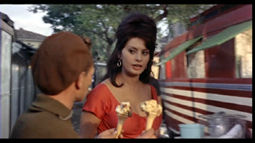 hear the sparse but effective score by Piero Umiliani, while pro cinematographer Armando Nannuzzi captures the laid-back, sunny atmosphere with an expert eye.
hear the sparse but effective score by Piero Umiliani, while pro cinematographer Armando Nannuzzi captures the laid-back, sunny atmosphere with an expert eye.
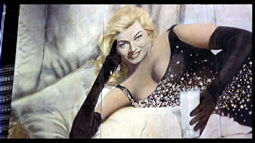 irritated with her wealthy but philandering lover (crime film favorite Tomas Milian, looking unrecognizably boyish here) who keeps funnelling all of his spare cash to prostitutes on the side. With the aid of her valet, she concocts a scheme to keep herself in clover while maintaing a grip on her man. Utterly beautiful and compelling, this note-perfect chamber piece may not offer Fellini's flash but reveals Visconti's immaculate flair for visual detail and dramatic pacing; the performers are all top-notch, and you could freeze nearly any frame and have a perfect painting. Very highly recommended. For some reason legendary cinematographer Giuseppe Rotunno, who shot most of Fellini and Visconti's classics during the 1960s, worked on this episode but not Fellini's, while Rota scored both.
irritated with her wealthy but philandering lover (crime film favorite Tomas Milian, looking unrecognizably boyish here) who keeps funnelling all of his spare cash to prostitutes on the side. With the aid of her valet, she concocts a scheme to keep herself in clover while maintaing a grip on her man. Utterly beautiful and compelling, this note-perfect chamber piece may not offer Fellini's flash but reveals Visconti's immaculate flair for visual detail and dramatic pacing; the performers are all top-notch, and you could freeze nearly any frame and have a perfect painting. Very highly recommended. For some reason legendary cinematographer Giuseppe Rotunno, who shot most of Fellini and Visconti's classics during the 1960s, worked on this episode but not Fellini's, while Rota scored both.
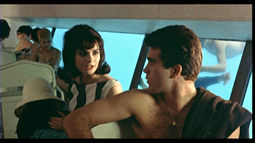 It's worth watching at least once, but prepare to go back to the Fellini and Visconti efforts far more often.
It's worth watching at least once, but prepare to go back to the Fellini and Visconti efforts far more often.
